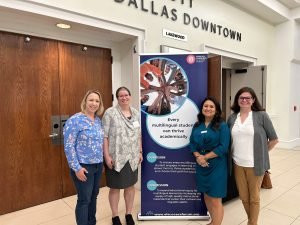While the number of multilingual learners in American schools has increased over the last twenty years, unfortunately, the achievement gap has remained unchanged. In September 2023, members of our Literacy, Science, and Math teams attended the English Learners Success Forum Fall Institute. The two days of intensive sessions provided attendees with in-depth training about how to design educational content to support the learning needs of multilingual learners.
Laura Cunningham, Emily O’Keefe Davenport, and Tara Hlavinka attended the Fall Institute and shared their takeaways:
“It was shocking to me to learn that the achievement gap for multilingual learners (MLLs) has not changed for 20 years. The materials that curriculum providers make needs to be a lever for equity.
The main takeaway for me is that there needs to be major shifts in curricular design to help curriculum providers use language in authentic ways. We can do this by supporting sense-making, optimizing output, cultivating conversations, and maximizing meta-awareness. Support for mult-language learners (MLLs) is- can sometimes be inadequate, with and supports are usually placed in a sidebar box or as an afterthought rather than being integrated into the learning materials. Curriculum providers need to shift their curricular design from prescribed to response, from silos to inclusion, and from add-ons to integrated support. This planning for language needs to be fundamental to the design of high-quality materials.”
– Laura Cunningham, Content Director, STEM
“The number of multilingual learners in schools is growing quickly, yet many teachers feel unprepared to meet these students’ needs. It is more important than ever to provide students with the resources they need to access grade-level material. This support means creating instructional materials that integrate language development and building content knowledge, along with meaningful scaffolds and the opportunity for students to learn from one another. I was grateful for the opportunity to explore how to honor and recognize the assets that multilingual learners bring, as well as ways to help them build language over time.”
– Emily O’Keefe Davenport, Senior Editor, Literacy
Features for multilingual learners in existing educational materials often do not provide the same rigor available to English-speaking students. Multilingual learners may have achieved conceptual understanding, even though they do not yet possess the language to explain their thinking academically. Curriculum should be designed to help teachers identify and be able to assess both language and understanding. To accomplish this, there is a great need for detailed, ongoing Professional Development for teachers, schools, and districts to reach every student and their families, along with high-quality educational materials.
– Tara Hlavinka, Senior Editor, Math
Creating educational materials that support learners in their learning trajectories is at the heart of Westchester Education’s work. Learn how we can help you develop new programs or update your existing materials to meet the needs of today’s students.
Subscribe to our blog
Categories
Related posts
ESSER Funding Winds Down as State Budgets Cool
By Jay Diskey, Diskey Public Affairs, LLC After four years of…
Reflecting on ISTE 2024
Takeaways from the Denver Conference by Christine DeFranco, Director, Client…
ASU+GSV Summit 2024
by Kevin Schroeder, Director, Client Solutions Having recently attended the…


